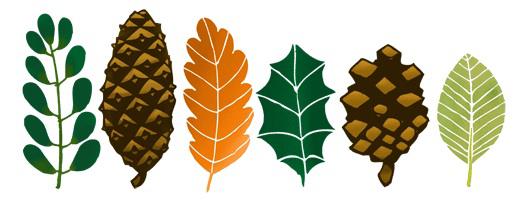 illustration: Matt Sewell
illustration: Matt Sewell
Emma Warren continues her mission to learn about trees:
The trees have begun to reveal themselves, now that they’ve finally come out of hiding and are covered in green nubs and curdle-coloured flowers, arboreal signifiers of their real selves.
At last!
I’ve spent the last month peering up trunks and along branches, trying to see if I could decipher unfurnished limbs just by looking at them. Funnily enough, they remained a mystery. I walked down countless roads, looking at trees that I couldn’t name, reciting what became an weirdly poetic rhyme: ‘don’t know/ don’t know/ don’t know/Silver Birch.’
Looking has been brilliant, not least because naming aspects of a landscape allows you to value it. When you see something, and find it’s proper name, it has more value. And it’s definitely more visible. I knew London was a green city but I’ve really realised how many trees we’ve got. They’re everywhere. Big fat ancient trees like the girthy Plane outside The American Church on Tottenham Court Road. I surreptitiously (or hopefully surreptitiously) put my arms around it. I’m 5”6 which makes it between a hundred and two hundred years old, and likely old enough to remember the “thirteen fine walnut trees on the north side between Hanover Yard and the Castle Inn, a little beyond the Star Brewery,” that Edward Walford noted in his 1878 book ‘Old And New London: Volume 4’.
Learning about trees, particularly in the city, makes you remember we’re not actually in the city – we’re on a natural planet, in nature, albeit in nature that has been pushed away organised, segmented and surrounded.
Take the tree in Brixton opposite Subway which has speakers in the branches. Or on Oxford St where the youthful looking specimens (genus currently unknown) which support big, boxy fairy lights. They’re only just taller than the top deck of the No 10 bus I’m on, and they’re quite close together. They’ll practically merge into one by the time they’re fully-grown in another half century or so. And that’s the thing: you’re really looking at the long game when you’re looking at trees.
Something else has happened since I started looking at trees: I keep noticing people who are being affectionate to each other. I’m looking out of the windows of the US Embassy, staring out some (unidentified trees) and their neighbours. A man is rubbing something from her cheek. He’s leaning in. She’s supplicant. He moves back. She offers him a bite of her croissant. It’s cute, cartoonish, moving. I wonder if people are just more affectionate underneath the watchful protection of a tree, or if the act of looking just slows you down so you see more. Either way, looking at trees and seeing them certainly takes you out of yourself.
The last month has also provided some moments of comedy and connection, as the process of learning causes us to stumble on tiny fragments of natural knowledge we may have had as children. This morning, with spring actually sprung, I pull down a branch from what looks like a horse chestnut. It is! The voila tree identification win is quickly followed by an unexpected madeleine moment: the sticky buds reminding me of a woodland creation myth I was told as a very small child about a pixie who made crockery out of acorn cups and who painted chestnut buds with glue to protect them from the birds.
And then I’m walking down a south London street with a friend, me probably going on about tree this, tree that.
Him: “That’s a silver birch.”
Me: “No its not. It’s not silver.”
Him: “It is! Look [pulls off bit of bark.] If I set fire to it it’ll go up in flames.”
The bark resolutely refuses to ignite and we laugh and immediately around the corner is a proper silver birch, all frozen luminescence and posed limbs like a dancer caught in a strobe.